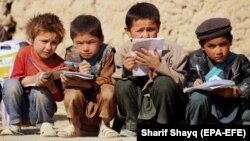Nearly half of Afghan children out of school, UNICEF says
| Publisher | Radio Free Europe/Radio Liberty |
| Publication Date | 3 June 2018 |
| Cite as | Radio Free Europe/Radio Liberty, Nearly half of Afghan children out of school, UNICEF says, 3 June 2018, available at: https://www.refworld.org/docid/5bc04e7c4.html [accessed 28 May 2023] |
| Disclaimer | This is not a UNHCR publication. UNHCR is not responsible for, nor does it necessarily endorse, its content. Any views expressed are solely those of the author or publisher and do not necessarily reflect those of UNHCR, the United Nations or its Member States. |
June 03, 2018 06:42 GMT
By RFE/RL
 The study notes that 85 percent of boys and girls who start at the primary level manage to stay in school to complete all grades.
The study notes that 85 percent of boys and girls who start at the primary level manage to stay in school to complete all grades.
Almost 3.7 million children in Afghanistan are unable to go to school due to ongoing conflict, poverty, and discrimination against girls, the United Nations' Children's Fund (UNICEF) says.
The figure, part of the Global Initiative On Out Of School Children report released on June 2, represents almost half of all Afghan children aged between 7 and 17.
It marks the first time that the out-of-school rate has increased since 2002, according to the study, which calls for a continued commitment on the part of the Afghan government and civil society groups to address the matter.
"Now is the time for a renewed commitment to provide girls and boys with the relevant learning opportunities they need to progress in life and to play a positive role in society," UNICEF Afghanistan Representative Adele Khodr said in a statement.
The report indicates that persistent discrimination against girls is a major factor driving down school attendance. Girls account for 60 percent of those being denied an education.
In the provinces of Kandahar, Helmand, Wardak, Paktika, Zabul, and Oruzgan, up to 85 percent of girls are not attending school.
But the study also notes that dropout rates are low, with 85 percent of boys and girls who start at the primary level managing to stay in school to complete all grades. The figures are even higher for those who begin at the secondary-school level.
The report comes as the Western-backed government in Kabul has been struggling to fend off the Taliban and other militant groups since the withdrawal of most NATO troops in 2014.
The Taliban has stepped up its attacks against Afghan security forces as well as government officials across the country since the announcement of its spring offensive in April.
Khodr insisted that getting girls and boys into school is "so much more than sitting in class." She said it is about providing routine and stability, "which is a wise investment given the insecurity across parts of the country."
"When children are not in school, they are at an increased danger of abuse, exploitation, and recruitment," she also said.
Link to original story on RFE/RL website
